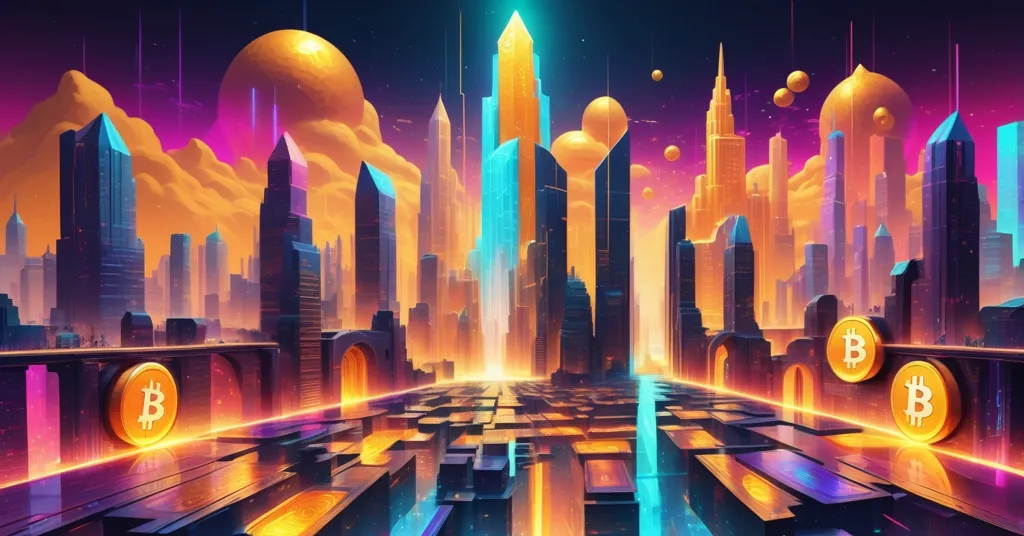NFTs and DeFi Rebound in Q3 Despite Bitcoin’s Dominance, DappRadar Reports

NFTs and DeFi Fight Back in Q3 as Bitcoin Dominates, DappRadar Reveals
Bitcoin might be the talk of the town with its price surges and institutional fanfare, but the decentralized underbelly of the crypto world is far from bowing out. The latest DappRadar report for Q3 shows a gritty resurgence in NFTs, DeFi, and gaming dapps, even as overall engagement takes a hit. While Bitcoin hogs the spotlight, these sectors are carving out their own paths, proving the blockchain space is a kingdom of many crowns.
- Daily dapp usage drops: Active wallets interacting with dapps fell 22.4% to 18.7 million.
- NFT surge: Sales soared to 18.1 million units, with trading volumes hitting $1.6 billion.
- Gaming and DeFi resilience: Gaming dapps claimed 25% of activity, while DeFi held at 17.9%.
Bitcoin’s Gravitational Pull: A Double-Edged Sword
Let’s not sugarcoat it: Bitcoin is a gravitational black hole right now, pulling focus and funds with relentless force. Whether it’s the buzz around spot ETF approvals, corporate treasuries like MicroStrategy stacking sats, or macroeconomic fears driving investors to digital gold, BTC is the headline act. But this dominance isn’t all sunshine for the broader crypto ecosystem. The DappRadar data, as detailed in a recent analysis of NFT and DeFi trends, shows a 22.4% drop in daily active wallets engaging with decentralized apps (dapps), down to 18.7 million in Q3 from the prior quarter. That’s a stark signal—capital and attention may be flowing to Bitcoin at the expense of innovation elsewhere.
As a Bitcoin maximalist at heart, I’ll argue BTC’s security, network effects, and store-of-value narrative make it the only crypto that matters for the long haul. Yet, playing devil’s advocate, Bitcoin’s design limits its role in niche use cases like fast, programmable transactions or complex financial systems. This is where altcoin ecosystems—think Ethereum, Solana, or even layer-2 solutions—step in. They power the dapps, NFTs, and DeFi protocols that Bitcoin can’t (and arguably shouldn’t) touch. So while BTC’s spotlight burns bright, it risks casting a shadow over experiments that could define the decentralized future. The question remains: are we letting a singular focus on Bitcoin starve out the very innovations that complement its mission?
NFTs: Shedding the ‘Overpriced JPEG’ Stigma
Can NFTs finally shake off their reputation as overpriced digital trinkets? The numbers from Q3 scream a tentative “yes.” After the 2021-2022 bubble burst left many holding worthless pixel art, NFTs are staging a comeback—not as speculative mania, but with hints of real utility. Sales skyrocketed to 18.1 million units from 12.5 million in Q2, with trading volumes swelling to $1.6 billion. Wallets interacting with NFTs grew by 28% to 2.14 million, each holding an average of over 8 items, and sales activity surged by an eye-popping 158%. For the uninitiated, NFTs—or non-fungible tokens—are unique digital assets on the blockchain, often tied to art, collectibles, or in-game items, with values that can swing from pennies to millions based on demand or purpose.
Marketplaces like OpenSea and Blur are fueling this revival, with activity spikes of 88% and 178%, respectively. OpenSea, the veteran platform, benefits from a trusted name and vast catalog, while Blur’s growth likely ties to whispers of token airdrops—crypto’s equivalent of dangling free candy. Collections like Pudgy Penguins, with their quirky charm, and Sorare, tapping into sports fandom with NFTs tied to real-world athletes, show niche communities driving engagement over mass hype. Even Moonbirds, now under Orange Cap Games after a stint with Yuga Labs, is stirring buzz with plans for a Solana-based token called BIRB.
Here’s the real shift: NFTs are evolving beyond “will this doodle make me rich?” into practical tools. Tokenization—think of it as owning shares of a company, but for digital art or real-world assets on the blockchain—is gaining traction. Take PUNKSTR tokens, which let investors own fractional pieces of blue-chip CryptoPunks without dropping millions. Then there’s integration with DeFi, where NFTs serve as collateral for loans or represent digital identities in decentralized systems. This pivot suggests a maturing market, aligning with our push for decentralization by democratizing access to high-value assets. But let’s not get carried away—sustainability is unproven. Many still chase hype, and airdrop-driven spikes could fizzle. Are we witnessing a true reinvention, or just another bubble in disguise?
DeFi: A Quiet Powerhouse Amid the Noise
Decentralized Finance, or DeFi—financial systems built on blockchain without banks or middlemen—remains a steadfast player, holding a 17.9% share of dapp activity in Q3. That’s no small feat when Bitcoin’s price action drowns out competing narratives. Protocols like Aave for lending, Uniswap for swapping tokens, and Curve for stablecoin trades continue to attract users who see value in cutting out traditional gatekeepers. Platforms like Kai-Ching, focused on everyday utility payments, further prove DeFi isn’t just for speculative degenerates; it’s inching toward practical use.
This resilience ties directly to our mission of financial freedom. DeFi challenges the old guard—central banks, Wall Street, the whole rigged system—by offering transparent, permissionless alternatives. Need a loan? No credit check, just collateralize your crypto. Want to earn interest? Skip the bank and stake in a liquidity pool. Yet, risks loom large. Smart contract bugs have led to millions in losses, and regulatory hawks are circling, ready to clamp down on what they can’t control. DeFi’s Q3 stability, compared to the 2021 bull run’s wild volatility, shows a sector hardening itself against storms. But with Bitcoin soaking up investment, can DeFi secure the capital to scale—or will it remain a niche rebellion?
Gaming Dapps: Play-to-Earn Keeps Users Hooked
Gaming dapps are sneaking up as a dark horse, claiming 25% of dapp activity in Q3, up from 20.1% in Q2. On the surface, that’s a win for interactive, blockchain-based experiences. Dig deeper, though, and many of these “games” are less about fun and more about DeFi mechanics in disguise—think earning crypto rewards by completing in-game tasks, akin to getting paid to play. This play-to-earn (P2E) model keeps users engaged, even as overall dapp usage slumps by 22.4%.
The appeal is obvious: who doesn’t love the idea of making money while gaming? But let’s play devil’s advocate. P2E models, like the infamous Axie Infinity, have a dark side—some veer into exploitative territory, with players in poorer regions grinding for peanuts while early investors cash out. Sustainability is shaky; if rewards dry up, so does the player base. Still, gaming dapps tap into a primal need for play and profit, proving blockchain can go beyond finance. They’re a messy but vital experiment—can they balance fun with fairness, or are they just yield farming with extra sprites?
AI and SocialFi: Hype Crashes into Reality
Not every crypto corner is thriving. Emerging sectors like AI-driven dapps and SocialFi—blockchain-based social platforms—are getting slapped down hard. Virtuals Protocol, an AI platform, saw daily active wallets plummet from 10,000 to a pathetic 1,000-1,500, with value transfers limping along at $100,000 daily. SocialFi apps like The Arena, Layer3, and OnchainGm fared no better, with a collective 50% activity drop to 1.57 million daily wallets. So, what’s the deal?
Frankly, it’s overhype meeting reality. SocialFi, which promises crypto rewards for social media interactions (think earning tokens for liking posts on a decentralized X), often feels like a gimmick with no soul. Do we really need blockchain to validate a retweet? AI in crypto, while flashy, struggles to deliver consistent value beyond buzzwords—Skynet it ain’t; more like a ghost town. These failures highlight a maturing market shedding dead weight. Blockchain excels at finance and ownership (DeFi, NFTs), but non-financial use cases? They’re often a stretch. Call me a skeptic, but these sectors look like shiny distractions with no legs—proof that not every idea deserves a token.
Crypto’s Segmented Future: Coexistence or Conflict?
Zooming out, the DappRadar findings paint a segmented crypto landscape. Bitcoin reigns as the ultimate store of value, its network unassailable after 15 years of battle-testing. Yet, dapp activity—down but not out at 18.7 million daily wallets—shows altcoins and decentralized protocols carving niches BTC doesn’t fill. Ethereum’s smart contracts power DeFi and NFTs, Solana’s speed fuels projects like Moonbirds’ BIRB token, and layer-2s like Arbitrum cut costs for dapp users. Bitcoin maximalists might scoff, calling these “distractions,” but I see necessary experiments. A decentralized future isn’t a monolith; it’s a mosaic.
Our push for freedom, privacy, and disruption of the status quo hinges on this diversity. Bitcoin secures the base layer of trust, while dapps and altcoins test the boundaries of what’s possible—be it tokenized art, permissionless loans, or play-to-earn economies. The risk is real, though: Bitcoin’s dominance could siphon capital from these experiments, leaving them underfunded and half-baked. As we champion effective accelerationism—pushing tech forward fast and hard—let’s ask ourselves: will we let Bitcoin’s shadow smother innovation, or can we build a future where every piece of the puzzle thrives?
Key Questions and Takeaways for Crypto Enthusiasts
- How are NFTs evolving beyond speculative assets?
They’re pivoting to utility through tokenization (like PUNKSTR for CryptoPunks) and DeFi integration, serving as collateral or digital IDs, while niche markets like sports (Sorare) drive community engagement over hype. - Why are gaming dapps gaining ground despite market fatigue?
Their 25% activity share stems from blending play-to-earn rewards with interaction, keeping users hooked even as overall dapp engagement drops by 22.4%—though sustainability remains a concern. - What’s causing the collapse of AI and SocialFi sectors?
Overhype and weak use cases are to blame; Virtuals Protocol’s user nosedive and SocialFi’s 50% activity slump suggest blockchain may not fit non-financial applications well. - Can DeFi sustain momentum with Bitcoin in the spotlight?
Holding a 17.9% activity share, DeFi’s resilience—via protocols like Aave and Uniswap—shows it can persist, though Bitcoin’s pull may limit investment in scaling these alternatives. - Does NFT utility advance the cause of decentralization?
Yes, tokenization and fractional ownership (e.g., PUNKSTR) democratize access to assets, while DeFi integration aligns with cutting out middlemen, though mass adoption is still a hurdle.



